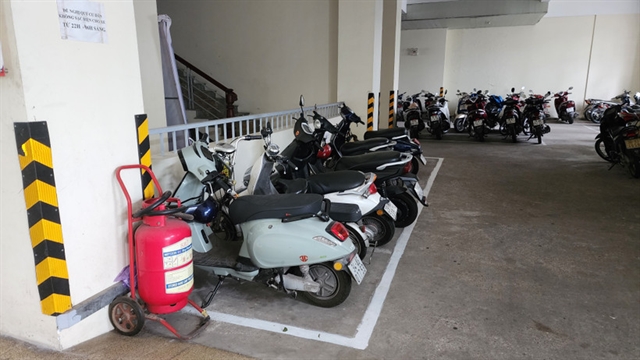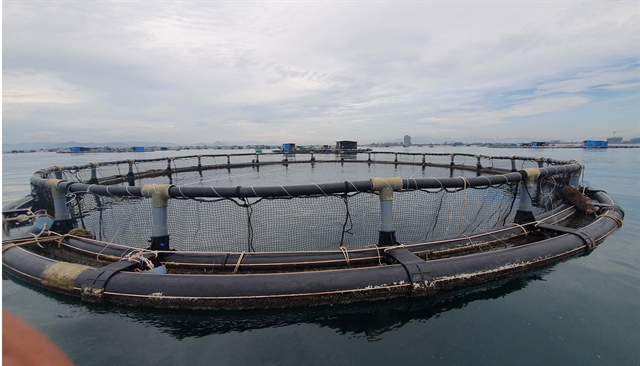 Business Beat
Business Beat


|
| A shrimp-rearing cage in Ninh Thuận Province. VNA/VNS Photo |
Compiled by Việt Dũng
HÀ NỘI — Natural aquatic resources are being used faster than they can replenish themselves, exposing the need for a sustainability transition in the fishery industry.
The Vietnam Directorate of Fisheries (VDF) revealed that marine capture fisheries contribute to 43 per cent of total fishery output and over 40 per cent of fishery exports.
The large contribution of catch-based fisheries can be attributed to the fact that Việt Nam has over 1 million sq.km of sea area available for aquaculture but a major part of the area is untapped.
Notably, offshore farms account for roughly 20 per cent of the total aquatic farming area in the country.
The directorate is aiming to accelerate the shift from catch-based to farm-based practices to improve fishery value chains and implement the governmental Scheme to develop marine aquaculture by 2030 with a vision to 2045.
"By 2030, marine aquaculture would reach 300,000ha with 12 million sq.m of cages, producing an annual output of 1.45 million tonnes," according to the scheme.
Nhữ Văn Cẩn, Director of the VDF's Aquaculture Department, asserted that room for aquaculture growth is ample as the country has a large area of coastal waters not-yet-exploited, which is estimated at 500,000ha.
He said the Ministry of Natural Resources and Environment has issued a decree on land lease and water surface lease to promote aquaculture. The decree allows a lease period of up to 50 years with an extension of 20 years for investors who want to make long-term investments in marine farming.
The Ministry of Agriculture and Rural Development (MARD) followed suit by urging the Government to develop a new decree to replace Decree 67. Under the new decree, fishermen who transition to farm-based practices would be granted a farming site located within 3 miles offshore. Some favourable policies also come with the sites to facilitate the transition.
Đỗ Đình Minh, Head of the Quảng Ninh Province's Sub-Department of Fisheries, claimed that the province has pulled off an annual growth rate of over 10 per cent in aquaculture.
Its farm-based output topped VNĐ4 trillion, contributing to 65 per cent of total provincial fishery output in 2021.
The sub-department head underscored quality seeds as the key to the success of mariculture. In the long-term, the province will re-organise farming areas in a way that breeding sites would be closely connected to rearing sites to yield the highest output and the best quality.
Trần Thanh Phong, Deputy Secretary General of the Vietnam Pangasius Association, opined that the sustainable growth of the pangasius sub-industry requires technology edge.
He mentioned several high-tech pangasius-rearing sites that have successfully employed technology to cut costs and operate more environmentally-friendly, and called for the replication of these sites across the country.
One such site is 600ha owned by Nam Viet Corporation, which uses an automated feeding system to cut labour costs and solar panel system to reduce electricity bills.
"We must aim to build concentrated pangasius-rearing sites, which incorporate the latest technologies into all their farming stages, to produce high value-added products that meet international demand," he said.
Lê Tấn Bản, Director of the Khánh Hòa Province's Department of Agriculture and Rural Development, said in the short term the province will grant water surface to certain fishermen under the Law on Fisheries 2017.
Eligible fishermen comprise local people who live on aquaculture and who have transitioned from coastal capture fisheries to farm-based fisheries.
The province will persuade the fishermen to use HDPE cages in place of traditional cages to make their cages better designed and more durable against ocean waves.
Deep-pocketed firms will be called on to invest further in mariculture to boost farm-based output. Fishery cooperatives, which are closely connected with the firms, will be established to keep the output stable.
According to MARD, capture fisheries consume 330 million litres of fuel per month. As fuel prices rose in the first half of 2022 amid unchanged fishery prices, many vessels had to temporarily cease operation on account of higher costs.
"About 40 to 55 per cent of vessels did not set sail for fishing in the first six months of the year," said the ministry.
Given the uncertainty of catch-based fisheries, and the fact that large importers have begun to set higher bar on fishery quality and traceability, farm-based fisheries seem to be a better path ahead. — VNS




